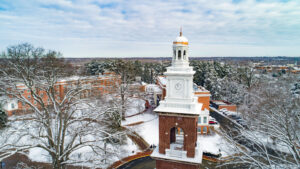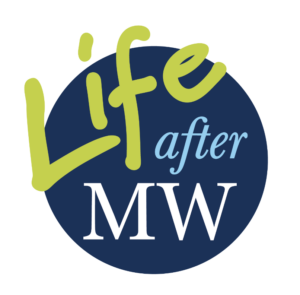
The University of Mary Washington has achieved a 10-year reaffirmation of accreditation from the Southern Association of Colleges and Schools Commission on Colleges (SACSCOC), as confirmed by the SACSCOC Board of Trustees during its annual meeting on Dec. 3.
“Once again, the University of Mary Washington has proved that ours is an education that matters,” said UMW President Troy Paino. “We appreciate all who contributed throughout the process and through their work each day, particularly our faculty and staff. Together, we achieve and sustain a high-quality, highly ranked educational experience that goes beyond the classroom through student learning opportunities and alumni accomplishments and connections.”
The reaffirmation process spanned more than a year with input and insight across the University, culminating in a March 2023 on-site visit by a committee of leaders from peer institutions. The committee met with students, faculty and staff, as well as board members, reviewing documentation, policies and practices, and finding zero areas for recommendations.
“Completion of the decennial reaffirmation process is validation of the quality and strength of the full scope of UMW’s operations as judged by our peers relative to the standards of accreditation. It is a testament to the good work of many across all divisions of our University,” said UMW Provost Tim O’Donnell.
 A key component of the reaffirmation process is the Quality Enhancement Plan, or QEP, better known as Life After Mary Washington: Preparing Students for Life and Career QEP, which focuses on 10 core competencies selected to support students as they transition into career and life after their time on campus. These competencies include career, self-development and professionalism; civic engagement and community service; communication; critical thinking and problem solving; digital fluency; global awareness and intercultural competency; leadership; meaningful connections; teamwork and collaboration; and well-being and mindfulness.
A key component of the reaffirmation process is the Quality Enhancement Plan, or QEP, better known as Life After Mary Washington: Preparing Students for Life and Career QEP, which focuses on 10 core competencies selected to support students as they transition into career and life after their time on campus. These competencies include career, self-development and professionalism; civic engagement and community service; communication; critical thinking and problem solving; digital fluency; global awareness and intercultural competency; leadership; meaningful connections; teamwork and collaboration; and well-being and mindfulness.
Adopted from the competency set defined by the National Association of Colleges and Employers (NACE), the criteria shape the student experience, already woven into the academic and co-curricular journey and now collected into a cultural pillar of student success. Complementary to general education requirements, Life After Mary Washington fosters student attainment of career-ready competencies, empowering students to effectively transfer and translate the undergraduate experience to the workplace, prepared for whatever comes next.
“Life After Mary Washington is about unified focus, common language and a cohesive approach to career readiness by the entire university community. The plan is a product of input from everyone –faculty, staff, students and employers. I’m grateful to all who dedicated their time and imagination to the development of this plan,” said UMW QEP Co-Chair and Associate Provost of Career and Workforce Kimberly Young.
For students, Life After Mary Washington will offer outcomes that connect their liberal arts and sciences education with 10 core competencies and instill the ability to communicate their experiences in a way that is relevant to their life and career after college. One tangible way these results are being collected and communicated is through a co-curricular transcript, providing students with the opportunity – online or printed – to showcase specific competencies and highlight activities, leadership roles, internships and volunteer activities. With access to more than 150 clubs and organizations, more than 25 sport clubs or intramural sports, and countless activities, internships and volunteer possibilities, UMW students can now document their experiences to chronicle their personal achievements and impress potential employers.
“Life After Mary Washington provides our students with applicable skills and competencies as they prepare for and navigate their post-graduation lives. The beauty of this plan is that it streamlines what the Mary Washington community already does well into specific and targeted goals. The development and implementation of this plan has been, and will continue to be, a team effort. We are so appreciative of our community’s support,” said UMW QEP Co-Chair and Associate Professor of Special Education Jennifer Walker.
As the plan unfolds, UMW will have an interim review and deliver a QEP impact report in 2028. The next reaffirmation of accreditation will take place in 2033.
“Preparing the compliance certification report for the reaffirmation process was a chance to reflect on and highlight the strengths of the University. Reaffirmation of our accreditation from SACSCOC with no recommendations for improvements is a recognition of the quality of the UMW experience,” said UMW Compliance Certification Coordinator and Professor of Chemistry Nicole Crowder.
The University of Mary Washington was first accredited by SACSCOC in 1930, and its accreditation was last reaffirmed in 2013.
SACSCOC is the recognized regional accrediting body in the 11 U.S. Southern states (Alabama, Florida, Georgia, Kentucky, Louisiana, Mississippi, North Carolina, South Carolina, Tennessee, Texas and Virginia) and in Latin America for those institutions of higher education that award associate, baccalaureate, master’s or doctoral degrees. To maintain accreditation with the Commission on Colleges, an institution must comply with the standards and requirements in The Principles of Accreditation: Foundations for Quality Enhancement and with the policies and procedures of the Commission on Colleges.



Congratulation and thanks to all who contributed to this exciting recognition.